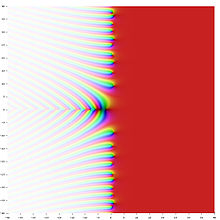
In mathematics, in the area of analytic number theory, the Dirichlet eta function is defined by the following Dirichlet series, which converges for any complex number having real part > 0:
:\eta(s) = \sum_{n=1}^{\infty}{(-1)^{n-1} \over n^s} = \frac{1}{1^s} - \frac{1}{2^s} + \frac{1}{3^s} - \frac{1}{4^s} + \cdots
This Dirichlet series is the alternating sum corresponding to the Dirichlet series expansion of the Riemann zeta function, ζ(s) — and for this reason the Dirichlet eta function is also known as the alternating zeta function, also denoted ζ*(s). The following simple rel...